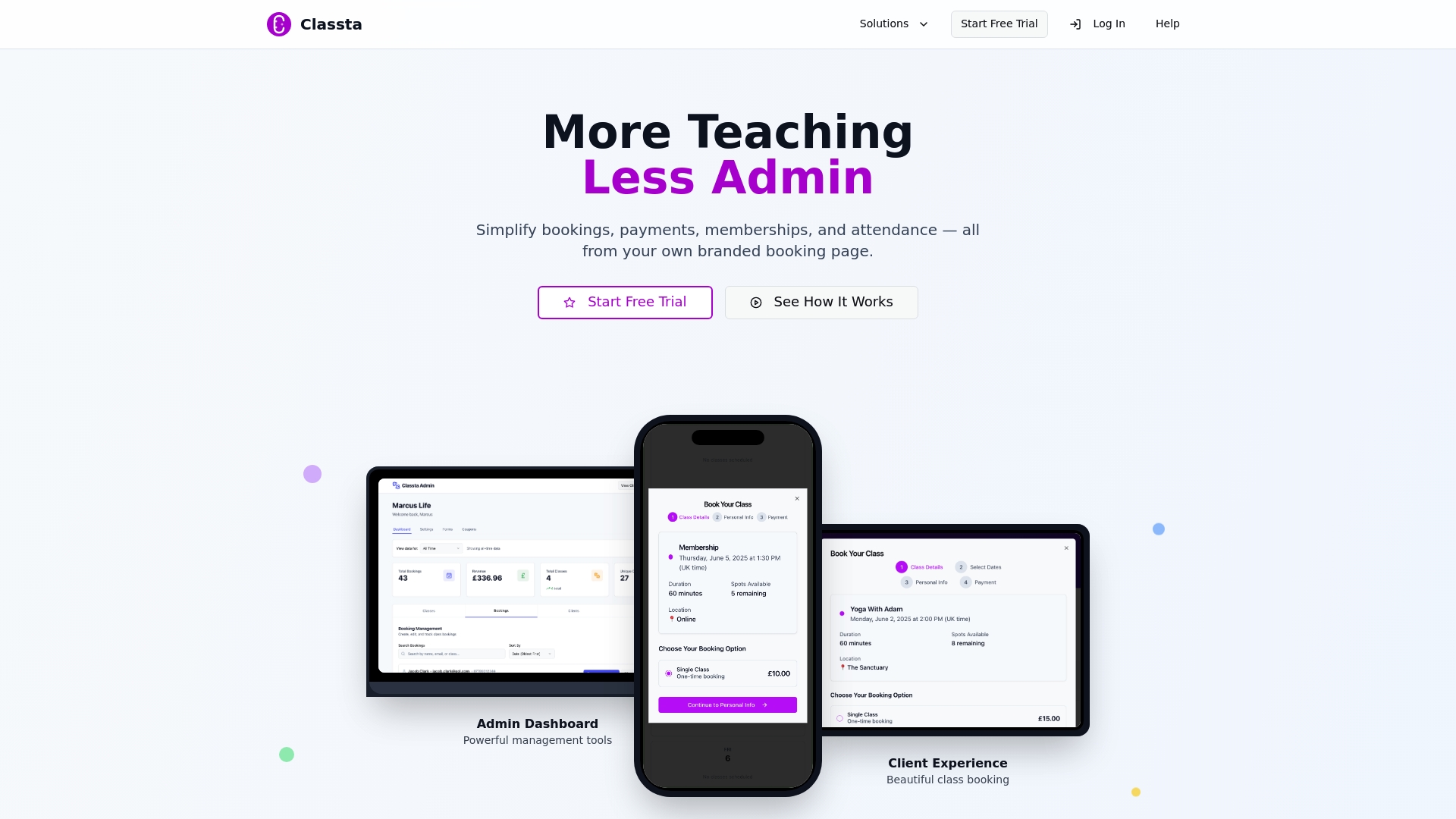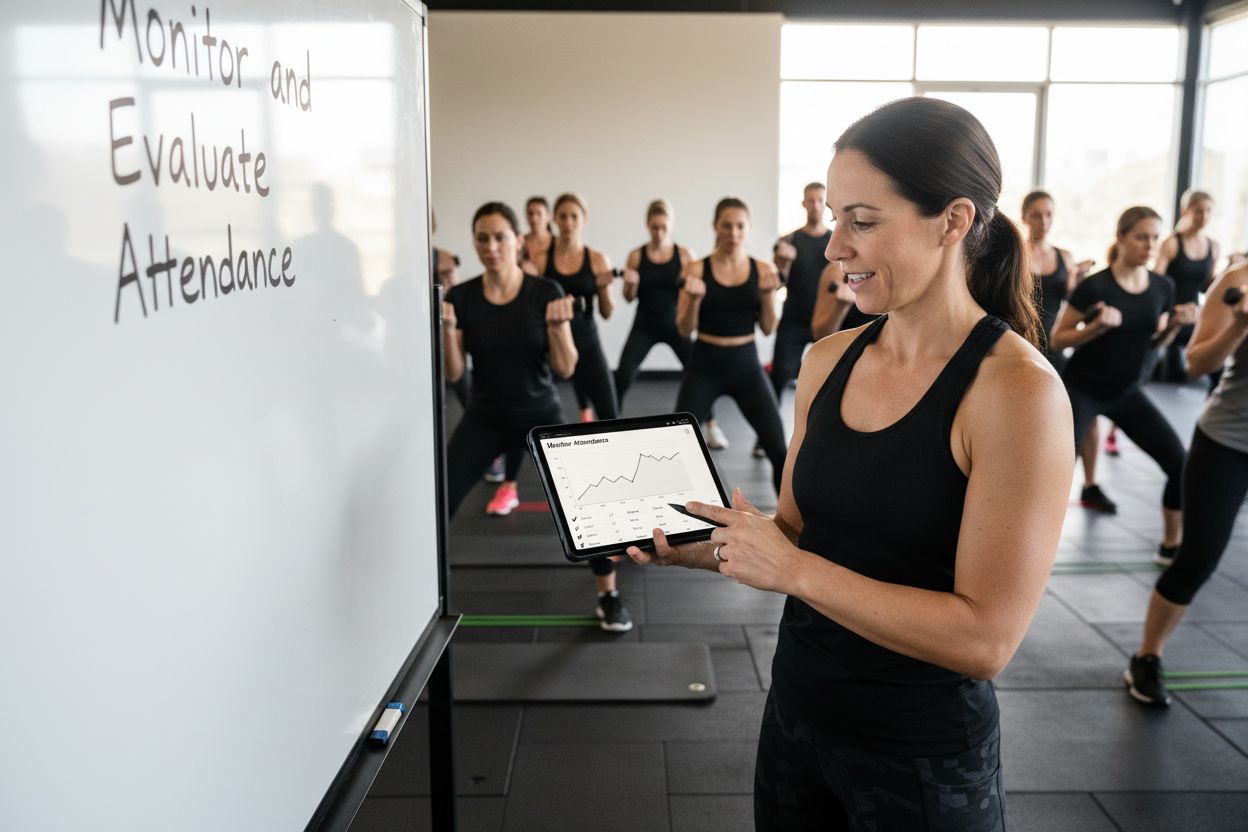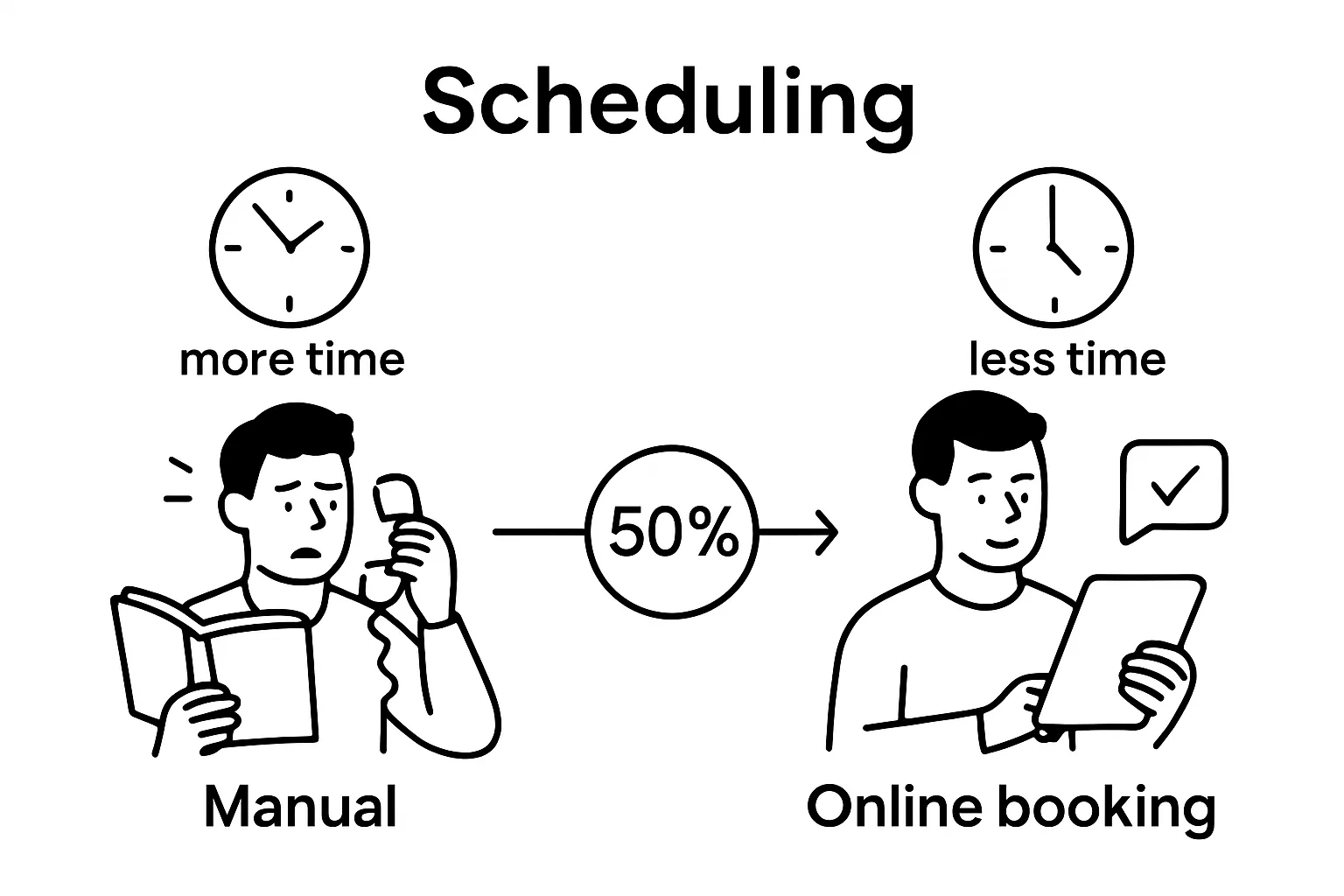Fitness classes are everywhere now, promising expert-led sessions in studios, parks, and even on your phone. You would expect most people to favour fast, solo routines at home. Yet traditional group classes remain timeless, and for good reason. Recent studies show group fitness classes still rank among the most popular exercise options, attracting people of all ages and abilities. The real surprise is not just the social buzz or the instructor’s motivation but how these diverse class formats keep evolving to cater for every experience level and lifestyle.
Table of Contents
Quick Summary
| Takeaway |
Explanation |
| Structured programmes enhance fitness results |
Traditional gym classes provide expert-led sessions that foster motivation and social interaction among participants. |
| HIIT saves time with effective workouts |
High-Intensity Interval Training offers efficient sessions that maximise calorie burn and fitness improvements in shorter timeframes. |
| Yoga adapts to individual wellness goals |
Modern yoga features various styles catering to different fitness levels and wellness objectives, making it accessible for everyone. |
| Pilates improves core strength and posture |
Pilates focuses on mindful movement and body awareness, enhancing flexibility and reducing injury risk through controlled exercises. |
| Outdoor classes boost mental well-being |
Exercising outside harnesses nature’s benefits, improving mood and reducing stress while offering a unique fitness environment. |
1: Traditional Gym Classes: An Overview
Traditional gym classes represent the cornerstone of fitness programming, offering structured group exercise experiences that cater to diverse fitness levels and goals. These classes provide participants with professional guidance, motivation, and a structured environment for achieving physical wellness.
In traditional gym settings, group fitness classes have evolved significantly over the past decades. Instructors design comprehensive programmes that target various fitness components, including cardiovascular endurance, muscular strength, flexibility, and overall conditioning. The primary appeal of these classes lies in their ability to combine expert instruction, social interaction, and systematic workout approaches.
Key characteristics of traditional gym classes include:
- Structured, instructor-led formats
- Fixed schedules and dedicated studio spaces
- Professional equipment and comprehensive programming
- Opportunities for social interaction and community building
According to American College of Sports Medicine, group fitness classes continue to be a popular modality for individuals seeking guided, motivational workout experiences. These classes typically range from 30 to 90 minutes and can accommodate varying fitness levels through modified exercise variations.
The effectiveness of traditional gym classes stems from their multifaceted approach to fitness. Participants benefit from professional guidance, structured progression, and the motivational energy of group dynamics. Instructors are trained to provide technical corrections, ensure proper form, and adapt exercises to meet individual needs while maintaining the class’s overall intensity and flow.
While technology and online platforms have expanded fitness options, traditional gym classes remain a powerful and engaging method for individuals to achieve their health and fitness objectives. They provide a holistic approach to wellness that combines physical training, social support, and professional expertise.
2: High-Intensity Interval Training (HIIT) Classes
High-Intensity Interval Training (HIIT) represents a revolutionary approach to fitness that has transformed traditional workout methodologies. HIIT classes deliver maximum results in minimal time, challenging participants through alternating periods of intense exercise and strategic recovery intervals.
The fundamental principle of HIIT involves pushing the body to its metabolic limits through short, explosive bursts of activity followed by brief rest periods. This training method has gained significant popularity due to its efficiency in burning calories, improving cardiovascular fitness, and boosting metabolic rate.
Key characteristics of HIIT classes include:
- Extremely time-efficient workouts (typically 20-30 minutes)
- Alternating high-intensity and low-intensity exercise intervals
- Minimal equipment requirements
- Adaptable to multiple fitness levels
Research from the Journal of Sports Science and Medicine indicates that HIIT can produce similar or superior fitness improvements compared to traditional moderate-intensity continuous training, but in significantly less time. Participants experience enhanced cardiovascular conditioning, increased fat oxidation, and improved insulin sensitivity.
Typical HIIT class structures might incorporate bodyweight exercises, cardio movements, resistance training, and functional fitness components. Instructors design sequences that challenge participants through rapid-fire movements, ensuring maximum muscle engagement and metabolic stimulation.
The versatility of HIIT makes it attractive for diverse fitness enthusiasts. From athletes seeking performance enhancement to busy professionals wanting efficient workouts, these classes provide a scalable and intense training experience. Advanced participants can increase complexity and difficulty, while beginners can modify exercises to match their current fitness levels.
As fitness trends continue evolving, HIIT remains at the forefront, offering a scientifically backed, time-efficient approach to achieving comprehensive physical conditioning.
3: Yoga Classes: Various Styles Explained
Yoga represents a holistic approach to physical and mental wellness, offering diverse styles that cater to different fitness goals, skill levels, and personal preferences. Modern yoga classes have evolved far beyond traditional practice, presenting practitioners with an expansive range of experiences designed to enhance strength, flexibility, mindfulness, and overall well-being.
The contemporary yoga landscape encompasses multiple distinctive styles, each with unique characteristics and philosophical foundations. Practitioners can select yoga classes that precisely match their individual wellness objectives and physical capabilities.
Primary yoga styles typically include:
- Hatha Yoga: Gentle, foundational practice focusing on basic postures
- Vinyasa Yoga: Dynamic, flow-based style emphasizing breath synchronisation
- Power Yoga: Intense, strength-building approach with continuous movement
- Restorative Yoga: Slow-paced, relaxation-oriented practice using supportive props
According to Harvard Health Publishing, regular yoga practice offers significant health benefits including stress reduction, improved cardiovascular functioning, enhanced muscle strength, and better mental clarity.
Yoga instruction has transformed from purely spiritual practice to a comprehensive fitness modality, integrating physiological understanding with mindfulness techniques. Contemporary classes often incorporate elements of anatomy, biomechanics, and psychological well-being, providing participants with a multi-dimensional wellness experience.
The accessibility of yoga has dramatically increased through specialized classes targeting specific demographics. From prenatal and senior yoga to athletic performance and rehabilitation-focused sessions, instructors now design highly targeted programmes that address nuanced physical and mental health requirements.
While traditional practices emphasised spiritual connection, modern yoga classes prioritise practical wellness outcomes, making this ancient discipline increasingly relevant in contemporary fitness landscapes. The versatility of yoga ensures its continued popularity across diverse population segments.
4: Pilates Classes: Benefits and Types
Pilates represents a sophisticated approach to body conditioning that focuses on core strength, precise movement, and holistic physical alignment. Developed by Joseph Pilates in the early 20th century, this discipline has transformed from a rehabilitation method to a comprehensive fitness practice embraced worldwide.
Modern Pilates classes offer diverse approaches that cater to different fitness levels, physical capabilities, and wellness objectives. The fundamental philosophy centres on developing muscular strength, improving posture, and enhancing body awareness through controlled, intentional movements.
Key Pilates class variations include:
- Mat Pilates: Bodyweight exercises performed on a fitness mat
- Reformer Pilates: Utilising specialised equipment with adjustable resistance
- Clinical Pilates: Rehabilitation-focused sessions targeting specific physical conditions
- Group Pilates: Dynamic, social group training experiences
Research from the International Journal of Sports Physical Therapy demonstrates that consistent Pilates practice can significantly improve core strength, flexibility, and overall muscular balance. Practitioners experience enhanced body mechanics and reduced risk of injury through systematic, mindful movement patterns.
Unlike high-intensity workout modalities, Pilates emphasises precision, control, and quality of movement over quantity. Instructors guide participants through carefully structured sequences that engage multiple muscle groups simultaneously, promoting comprehensive physical conditioning.
The versatility of Pilates makes it accessible to diverse populations. From professional athletes seeking performance enhancement to individuals managing chronic pain or recovering from injuries, these classes offer scalable, low-impact fitness solutions.
As fitness trends continue evolving, Pilates remains a scientifically validated approach to physical wellness, combining biomechanical understanding with mindful movement principles.
Dance fitness classes have revolutionised group exercise by transforming traditional workout experiences into vibrant, music-driven movement celebrations. These classes blend cardiovascular training with rhythmic choreography, creating an immersive fitness experience that feels more like entertainment than exercise.
Modern dance fitness formats have evolved far beyond simple aerobic movements, incorporating diverse musical styles, cultural dance traditions, and innovative training techniques. Participants engage multiple muscle groups while enjoying high-energy, social workout environments that make physical activity feel enjoyable and spontaneous.
Popular dance fitness class formats include:
- Zumba: Latin-inspired dance choreography with international music
- Hip Hop Fitness: Urban dance moves combined with strength training
- Bollywood Dance Fitness: High-energy Indian dance-based workouts
- Caribbean Dance Cardio: Caribbean rhythm-focused movement sequences
According to Journal of Sports Science and Medicine, dance fitness classes provide substantial cardiovascular benefits while maintaining significantly higher participant engagement compared to traditional exercise modalities.
The psychological benefits of dance fitness extend beyond physical conditioning. These classes create supportive, inclusive environments that reduce exercise intimidation, particularly for individuals who might feel uncomfortable in conventional gym settings. Instructors focus on creating welcoming atmospheres where participants can express themselves freely while improving fitness.
Technical complexity varies across different dance fitness formats, allowing participants to select classes matching their coordination levels and personal preferences. Beginners can find modified versions, while advanced dancers can explore more intricate choreographic sequences.
As fitness trends continue evolving, dance fitness remains a dynamic, culturally rich approach to physical wellness, proving that exercise can be simultaneously effective and genuinely enjoyable.
6: Specialty Classes: Merging Fitness with Wellness
Specialty fitness classes represent an innovative approach to holistic health, transcending traditional exercise paradigms by integrating comprehensive wellness strategies. These classes blend physical training with targeted therapeutic and mindfulness techniques, offering participants multidimensional approaches to personal health management.
Contemporary specialty classes recognise that fitness extends beyond muscular development and cardiovascular conditioning. They emphasise holistic transformation encompassing mental, emotional, and physical well-being.
Emergent specialty class formats include:
- Mindful Movement Therapy: Combining meditation with gentle physical exercises
- Rehabilitation-focused Fitness: Personalised programmes for injury recovery
- Stress Management Fitness: Classes targeting mental health through physical activity
- Hormonal Balance Workouts: Exercise sequences designed for specific physiological needs
Research from the International Journal of Yoga Therapy demonstrates that integrative fitness approaches can significantly improve overall health outcomes by addressing multiple wellness dimensions simultaneously.
Specialty classes offer personalised experiences that acknowledge individual physiological differences. Instructors undergo advanced training to understand complex interactions between movement, psychology, and physical health, enabling them to design nuanced programmes that adapt to participants’ unique requirements.
These classes represent a paradigm shift from generic fitness models towards more sophisticated, scientifically informed wellness strategies. By recognising that health is a complex, interconnected system, specialty classes provide targeted interventions that support comprehensive personal development.
As healthcare perspectives continue evolving, specialty fitness classes are emerging as powerful tools for proactive wellness management, bridging traditional exercise methodologies with advanced understanding of human physiological and psychological functioning.
7: Outdoor Fitness Classes: Connecting with Nature
Outdoor fitness classes represent a transformative approach to exercise that breaks free from traditional indoor training environments. These dynamic classes leverage natural landscapes as comprehensive fitness platforms, offering participants unique opportunities to combine physical conditioning with environmental engagement.
The fundamental appeal of outdoor fitness classes lies in their ability to provide holistic wellness experiences that extend beyond conventional workout methodologies. Participants benefit from fresh air, natural terrain variations, and psychological advantages of outdoor training.
Diverse outdoor fitness class formats include:
- Bootcamp-style Group Training: High-intensity exercises in parks and open spaces
- Trail Running Workshops: Guided running sessions through natural terrain
- Beach Fitness Programmes: Resistance training utilising sand and coastal environments
- Mountain Fitness Classes: Strength and endurance training in challenging landscapes
According to Environmental Science and Technology, outdoor exercise provides significant mental health benefits, including reduced stress, improved mood, and enhanced psychological well-being compared to indoor training environments.
Outdoor fitness classes challenge participants through unpredictable environmental conditions, requiring enhanced proprioception, adaptability, and functional movement skills. Instructors design programmes that leverage natural elements like uneven terrain, environmental resistance, and spatial complexity to create comprehensive training experiences.
The sustainability and accessibility of outdoor fitness classes make them increasingly attractive for diverse fitness enthusiasts. By eliminating equipment barriers and reducing operational costs, these classes democratise fitness experiences and encourage community participation.
As fitness trends continue evolving, outdoor classes represent a powerful intersection between physical training, environmental connection, and holistic wellness strategies, offering participants innovative approaches to personal health management.
8: Online Fitness Classes: Expanding Your Reach
Online fitness classes have revolutionised exercise delivery, transforming how instructors connect with participants and how individuals engage with fitness programming. Digital platforms enable fitness professionals to transcend geographical limitations, creating flexible, accessible wellness experiences that adapt to modern lifestyle demands.
The digital fitness landscape offers unprecedented opportunities for personalisation, scalability, and innovative content delivery. Instructors can now design comprehensive programmes reaching global audiences while maintaining high-quality, interactive training experiences.
Key advantages of online fitness classes include:
- Global audience accessibility
- Flexible scheduling options
- Lower overhead costs for instructors
- Diverse content delivery methods
Research from the International Journal of Environmental Research and Public Health demonstrates that online fitness classes can be equally effective as traditional in-person training, particularly when incorporating interactive technologies and personalised feedback mechanisms.
Digital platforms enable sophisticated tracking and customisation capabilities that traditional fitness environments struggle to replicate. Instructors can utilise advanced analytics, real-time performance monitoring, and adaptive programming techniques to enhance participant engagement and results.
Technological advancements have democratised fitness education, allowing instructors to create specialised content across multiple disciplines. From yoga and pilates to high-intensity interval training, online platforms support diverse fitness modalities with minimal equipment requirements.
As digital connectivity continues expanding, online fitness classes represent a dynamic intersection between technology, wellness, and personal development, offering flexible, innovative approaches to achieving health and fitness objectives.
9: Trends in Fitness Classes: Staying Ahead of the Game
The fitness industry continuously evolves, driven by technological innovations, changing consumer preferences, and emerging scientific understanding of human physiology. Modern fitness classes are transforming from traditional exercise models into comprehensive wellness experiences that address holistic health through integrated approaches.
Contemporary fitness trends reflect a profound shift towards personalisation, technological integration, and comprehensive well-being strategies. Instructors and fitness professionals must remain adaptable and forward-thinking to meet increasingly sophisticated participant expectations.
Emerging fitness class trends include:
- AI-powered personalised training programmes
- Mental health and fitness integration
- Sustainable and environmentally conscious fitness experiences
- Micro-targeted wellness classes
According to ACSM’s Worldwide Survey of Fitness Trends, wearable technology, online training, and body weight training continue to dominate fitness industry developments.
Technology is fundamentally reshaping fitness class delivery and participant engagement. Advanced platforms now offer real-time biomechanical analysis, personalised performance tracking, and adaptive programming that responds dynamically to individual participant metrics.
The future of fitness classes will likely emphasise individualised experiences that combine physical training with psychological wellness, nutritional guidance, and data-driven performance optimization.
Below is a comprehensive table summarising the core types, features, and benefits of the nine fitness class formats detailed in the article, providing a complete overview for readers.
| Fitness Class Type |
Key Features |
Principal Benefits |
Distinctive Aspects |
| Traditional Gym Classes |
Instructor-led, group setting, structured workouts |
Motivation, social support, all-round fitness |
Expert guidance, variety, professional equipment |
| High-Intensity Interval Training |
Short, intense exercise bursts with recovery periods |
Time-efficient, high calorie burn, improved cardiovascular health |
Adaptable to all levels, minimal equipment |
| Yoga (Various Styles) |
Diverse approaches (Hatha, Vinyasa, Power, Restorative) |
Flexibility, strength, stress reduction, mindfulness |
Accessible, targets unique wellness goals |
| Pilates |
Core-focused, controlled movements, mat or equipment-based formats |
Core strength, improved posture, injury prevention |
Precision emphasis, scalability, rehabilitation uses |
| Dance Fitness |
Music-driven choreographed sessions (e.g., Zumba, Hip Hop, Bollywood) |
Cardiovascular health, enjoyment, higher engagement |
Inclusive, fun, lowers intimidation barrier |
| Specialty Classes |
Integrates therapy/mindfulness (e.g., stress relief, rehab, hormones) |
Holistic wellness, personalisation, mental health support |
Advanced instructor expertise, targeted programmes |
| Outdoor Fitness |
Conducted in parks, beaches, mountains, or trails |
Mental well-being, mood boost, physical variety |
Environmental engagement, functional movement |
| Online Fitness |
Digital platforms, global accessibility, interactive content |
Convenience, reach, flexibility, personalised feedback |
Lower costs, analytics-driven, scalable |
| Fitness Class Trends |
Focus on tech, sustainability, mind-body integration, personalisation |
Personalised, future-proof experiences, comprehensive wellbeing |
AI/tech integration, micro-targeted classes |
As wellness perspectives become more nuanced, fitness classes are transforming from mere physical training environments into comprehensive personal development platforms that support holistic human potential.
Growing a thriving fitness business should be energising, not overwhelming. If you have ever felt overburdened by endless admin, missed client reminders, or the struggle to juggle class schedules and membership plans—especially as more class types and client preferences emerge—it is time to break free from manual processes. As you have learned, offering a diverse range of classes like HIIT, yoga, Pilates, and specialty sessions can accelerate your business. Yet, these options also demand seamless bookings, secure payments, and effortless membership management to deliver the professional client experience today’s fitness seekers expect.

Take the next step with Classta.co, the all-in-one platform tailored for fitness instructors and class providers. Streamline your business with branded booking pages, automated reminders, secure online payments, and recurring membership billing—all designed to put your focus back on coaching, not paperwork. Let Classta handle the complexity so you can scale up confidently and give your members a smoother, more personal journey. Make the switch today and unlock the tools that help you grow faster, boost client satisfaction, and future-proof your fitness offering. Explore the difference at Classta.co and take charge of your success.
Frequently Asked Questions
What are traditional gym classes and their benefits?
Traditional gym classes are structured group exercise sessions led by professional instructors that cater to various fitness levels. They provide professional guidance, motivation, and opportunities for social interaction, making them effective for achieving physical wellness through expert instruction and systematic workout approaches.
How does High-Intensity Interval Training (HIIT) differ from traditional workouts?
HIIT classes involve short bursts of intense exercise followed by brief recovery periods, making them time-efficient and effective for burning calories and improving cardiovascular fitness compared to traditional moderate-intensity workouts. They can produce similar or superior fitness improvements in a fraction of the time.
What styles of yoga are available in contemporary fitness classes?
Contemporary yoga classes feature a range of styles such as Hatha (gentle and foundational), Vinyasa (dynamic and flow-based), Power (intense strength-building), and Restorative (slow-paced and relaxation-oriented), catering to different fitness goals and skill levels.
What makes outdoor fitness classes beneficial?
Outdoor fitness classes leverage natural environments, providing fresh air and terrain variations that enhance the workout experience. They offer significant mental health benefits, including reduced stress and improved mood, while challenging participants with unpredictable conditions that require adaptability.























